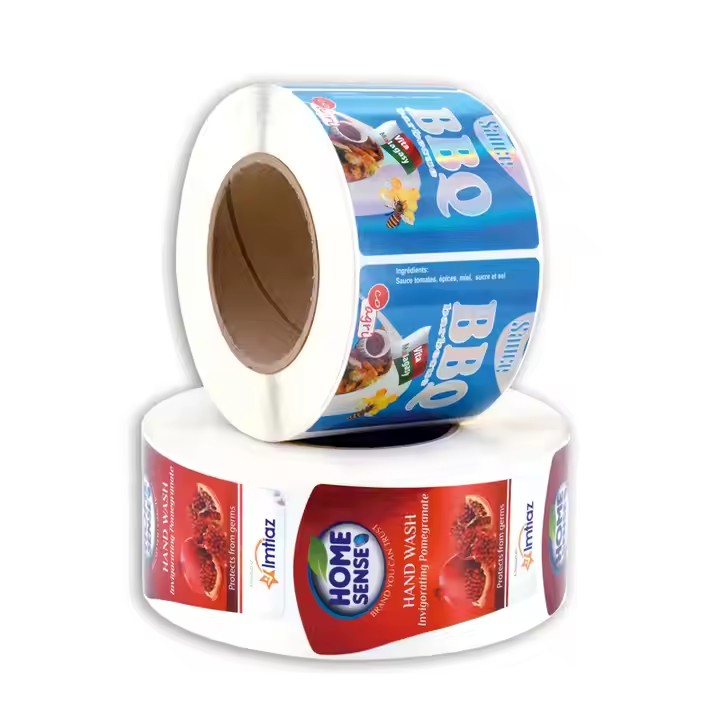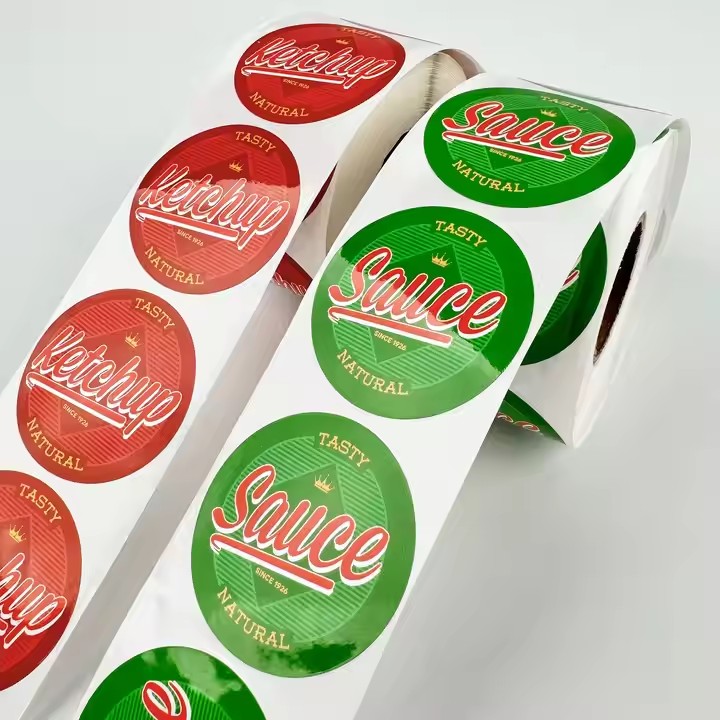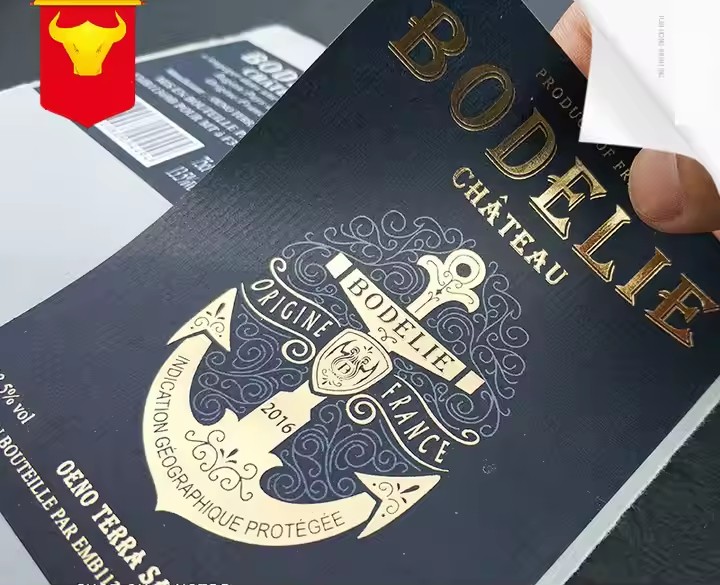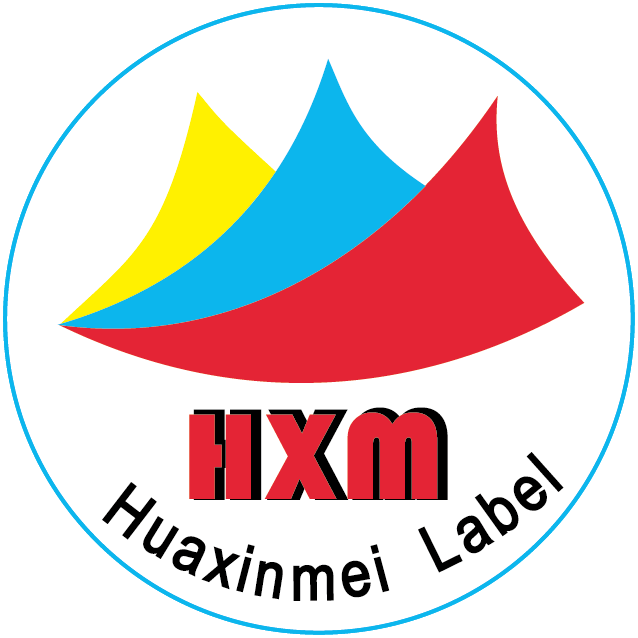Shape Design
Based on the Bottle Outline: If the bottle body is a regular cylinder, the bottle sticker can be designed as a rectangle or a circle, perfectly wrapping around or covering the surface of the bottle body. For bottles with special outlines, such as those with edges, curves, or concave – convex shapes, the sticker shape should be customized according to these unique outlines to ensure a tight fit. For example, for an irregular – shaped perfume bottle, the sticker can be designed to echo the curves of the bottle body. When designing, it is necessary to measure the bottle body in advance. Design a more perfect and better – fitting label according to the size and shape of the bottle body.
Considering the Bottle Structure: Some bottles may have special structures such as bottlenecks, shoulders, or bottoms. When designing the sticker, these parts should be fully considered. The sticker can be divided into multiple parts to adapt to different structures respectively. For example, a narrow – strip sticker can be designed for the bottleneck, and a larger sticker can be used for the main body of the bottle, making the whole look harmonious and unified. Since the contents of the bottles vary, it is necessary to design labels that are as close as possible to the bottle structure. Some bottles are not perfectly round and have many surfaces. Only by fully considering the bottle structure can the best labels be designed.

Size Control
Accurate Measurement: Before designing, the bottle body needs to be accurately measured, including dimensions such as circumference, height, and diameter, to ensure that the size of the sticker completely matches the bottle body. Generally, the height of the sticker should be slightly smaller than the height of the sticker – applicable area on the bottle body to avoid wrinkles or stretching when the sticker is pasted. Accurately measure the height of the bottle body to design a label that matches it. A label that is too large or too small won’t do. Only accurate measurement can lead to a good label design. When designing the label, fine – tuning is also necessary because only a label of the right size can fit the bottle body perfectly when pasted.
Space Reservation: Consider the pasting position and method of the sticker on the bottle body. If it is wrapped around and pasted, a certain overlapping part needs to be reserved for pasting and fixing. If it is locally pasted, the size and position of the sticker should be reasonably determined according to the visual focus and information display requirements of the bottle body. For example, for a sticker pasted only on the front of the bottle body, the width can account for one – third to one – half of the bottle’s circumference. Regarding the size of the label design, sufficient space should be reserved on the bottle. When the label is attached to the bottle body, it should neither be too much nor too little.
Pattern and Color
Visual Extension: Create a visual extension effect of the entire bottle body through pattern design. For example, draw continuous lines, patterns, or gradient colors on the bottle sticker so that after wrapping around the bottle body, it forms a complete visual image, integrating the sticker with the bottle body. To achieve visual extension, the pattern on the bottle should be designed to have an extended effect as much as possible, making the entire bottle body richer and more three – dimensional.
Color Matching: Choose a color scheme that coordinates with the color of the bottle body. If the bottle body is transparent, the color of the sticker can be matched according to the color of the contents. If the bottle body has a color, complementary colors or analogous colors can be used for matching to enhance the overall visual effect. At the same time, pay attention to the color contrast to ensure that the information on the sticker is clearly readable. Color matching is also very important because it concerns whether consumers will buy the product in the bottle. Only bottles with a designed and aesthetically pleasing appearance can attract more consumers.

Material Selection
Flexibility: Select sticker materials with good flexibility, such as PVC, PET and other film materials. They can better adapt to the shape of the bottle body, especially on curved or irregular surfaces, and can maintain a good fit, without being prone to bubbles or wrinkles. Since the label is pasted on the bottle body, a sticker with better flexibility should be chosen to be as close to the bottle body as possible. Only a sticker with good flexibility can be attached to the bottle body. If it is too stiff, it will not fit properly.
Elasticity: For some bottle bodies with arcs or those that need to be stretched and pasted, materials with certain elasticity can be selected, such as rubber stickers or special elastic films, which can automatically adjust according to the shape of the bottle body during pasting to ensure a tight fit.
Process Treatment
Die – cutting Process: Use die – cutting technology to cut the sticker into an outline that precisely matches the shape of the bottle body. This can achieve accurate cutting of complex shapes, making the fit between the sticker and the bottle body closer and the edges neater. The labels produced need to adopt high – end cutting technology to be cut well. If the die – cutting technology is inaccurate, it is likely to produce some labels with insufficient precision, resulting in waste in label production, which is a waste for both the manufacturer and the customer, and can have a significant impact on the launch of new products.

Curved – surface Printing: Adopt curved – surface printing technology to directly print patterns on the bottle body, making the patterns perfectly fit the curved surface of the bottle body. The visual effect is more natural and smooth, avoiding possible gaps or unevenness between the sticker and the bottle body.


